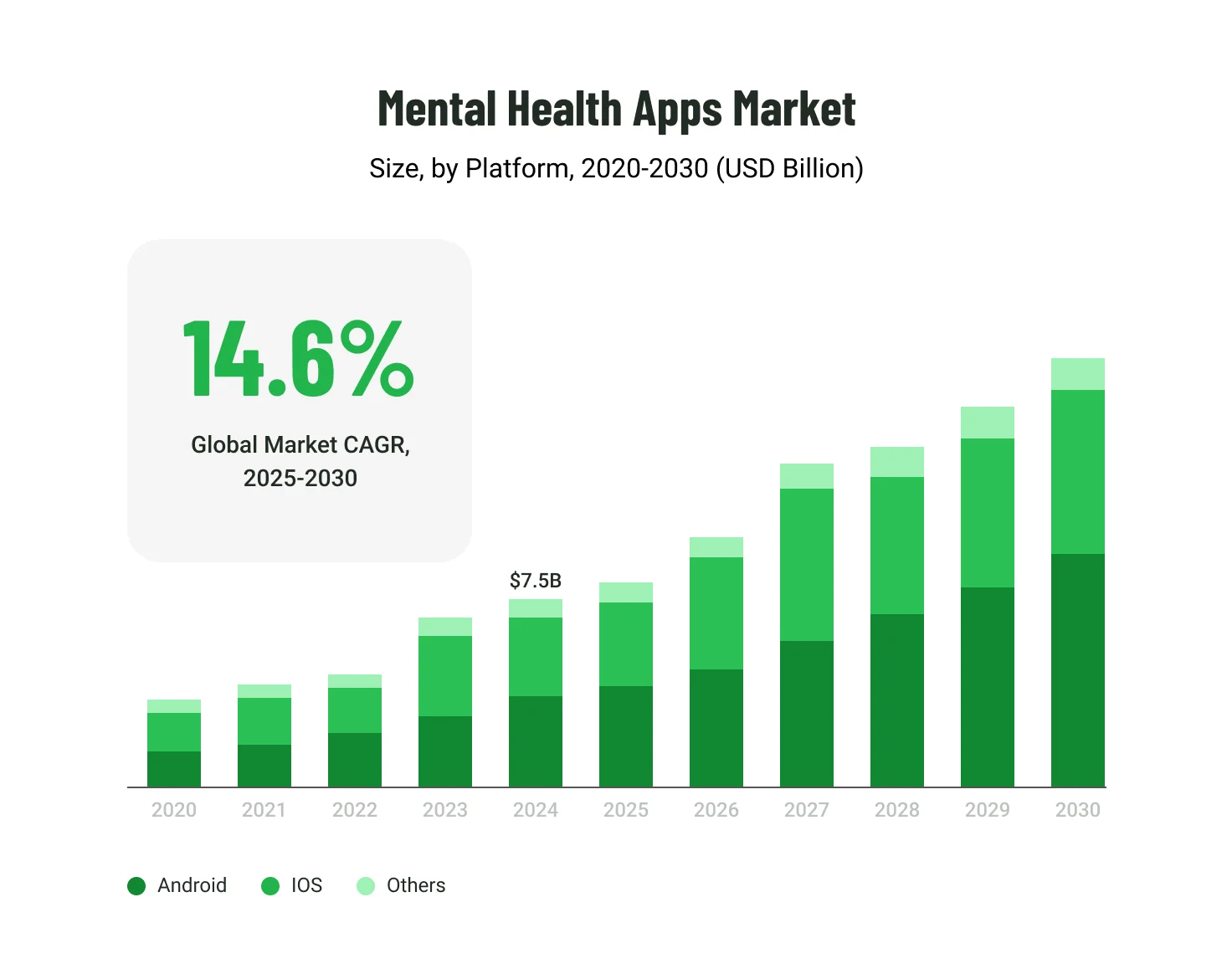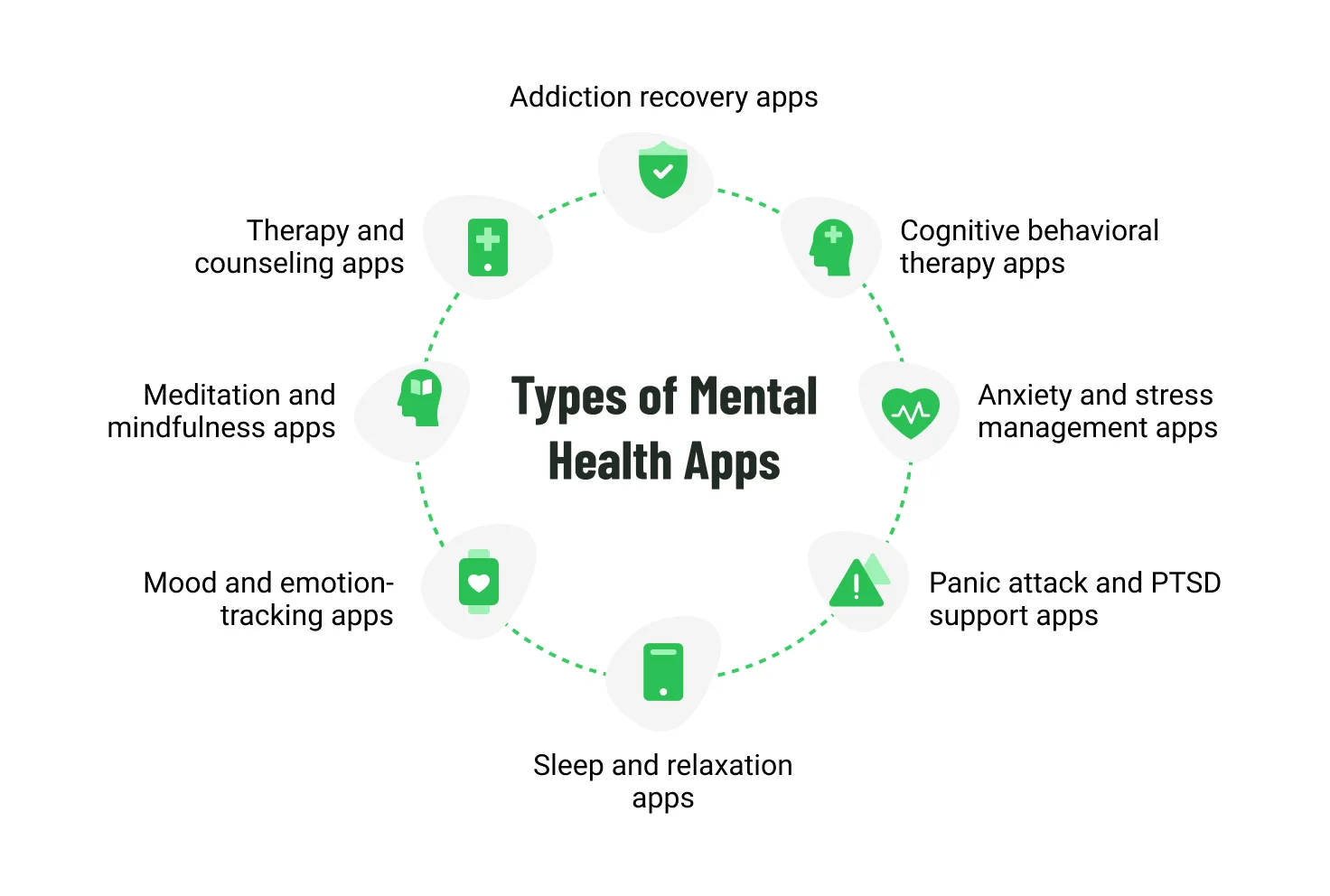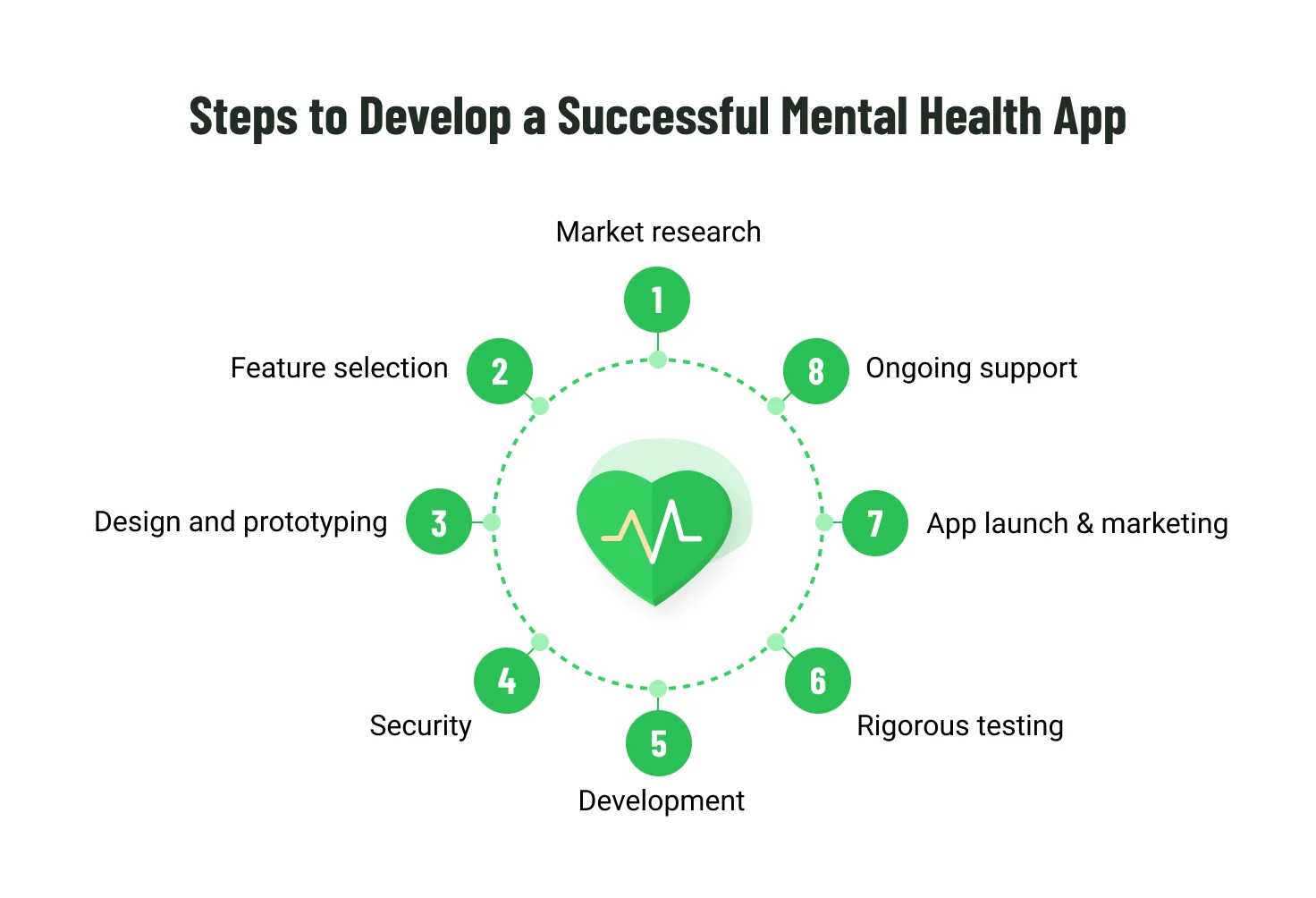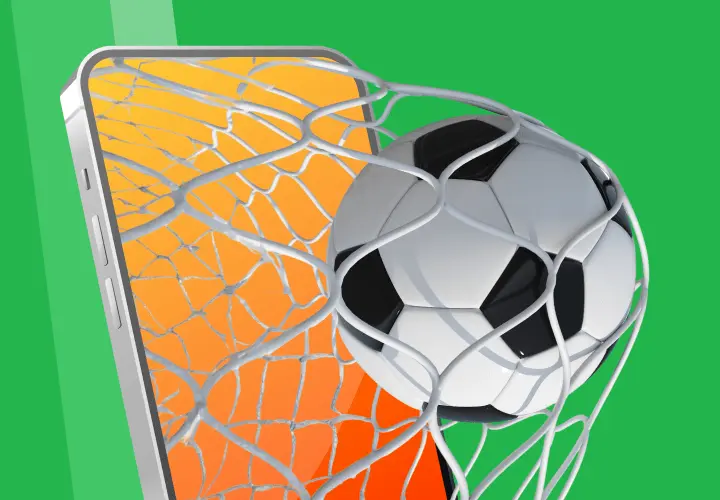Building a Mental Health App: Development Insights and Tips
Table of contents
- Understanding the Major Types of Mental Health Apps
- Therapy and counseling apps
- Meditation and mindfulness apps
- Mood and emotion-tracking apps
- Sleep and relaxation apps
- Anxiety and stress management apps
- Addiction recovery apps
- Cognitive behavioral therapy (CBT) apps
- Panic attack and PTSD support apps
- Top Features of Mental Health Apps
- User-friendly interface
- Personalized user experience
- Goal-setting and progress-tracking
- Calendar, notifications, and reminders
- Community support
- Offline functionality
- Gamification
- Sleep tracking
- Trigger trackers
- On-demand video and audio content
- Integration with wearables
- A Step-by-Step Guide to Developing a Successful Mental Health App
- 1. Conduct in-depth market research
- 2. Select essential features for your app
- 3. Design and prototype your app
- 4. Ensure data privacy and security
- 5. Develop the app
- 6. Conduct rigorous testing
- 7. Plan a strategic app launch & marketing
- 8. Ongoing support and maintenance
- How Much Does It Cost to Develop a Mental Health App?
- 1. App’s complexity
- 2. Features
- 3. Platform: iOS, Android, or both?
- 4. Security & compliance requirements
- Simple mental health app
- More complex mental health app
- Mental health app with advanced features and customization
- Enterprise-level mental health app
- Challenges in Mental Health App Development
- 1. Data privacy and security
- 2. Compliance with health regulations in different countries
- 3. Ensuring scientific accuracy
- 4. Integration with other healthcare systems
- Final Thoughts
In today's fast-paced world, more people than ever are seeking effective ways to manage stress, overcome mood disorders, and address various psychological challenges. As mental health awareness grows, so does the demand for digital solutions to support emotional well-being. From meditation and cognitive therapy apps to AI-driven mental health companions, these technologies vary widely in purpose, functionality, and target audience. However, developing a mental health app is a complex process that requires a deep understanding of psychological principles, strict compliance with healthcare regulations, and a user-centric approach to ensure safety and effectiveness.

The mental health app market is experiencing rapid growth, driven by the increasing need for accessible and affordable mental health support. According to Grand View Research, in 2024, the global mental health app market was estimated at $7.5 billion, with projections indicating a compound annual growth rate (CAGR) of 14.6% from 2025 to 2030. Advancements in telehealth, widespread smartphone adoption, and investments in digital healthcare innovations fuel this surge. With millions of users turning to mobile apps for mental wellness support, the opportunity for businesses to enter this space has never been greater—but success requires careful planning, innovation, and adherence to industry standards.
Mental health is no longer confined to medical institutions; it has become a critical aspect of overall well-being, influencing productivity, relationships, and quality of life. Factors like work-related stress, social media pressures, and the lingering effects of global crises have intensified the need for accessible mental health resources. Governments, employers, and healthcare providers recognize the significance of proactive mental health management, leading to an increased focus on digital solutions that empower individuals to take control of their emotional health.
This article will guide you through the essential aspects of mental health app development, helping you understand the key features, regulatory requirements, and best practices to build a solution that truly makes a difference in users' lives. Whether you're a startup venturing into the mHealth industry or an established company looking to expand your digital healthcare offerings, this comprehensive guide will equip you with the knowledge needed to succeed.
Understanding the Major Types of Mental Health Apps
With the increasing demand for digital mental health support, various apps have emerged to address different psychological needs. Whether helping users manage anxiety, track emotions, or connect with licensed therapists, these apps provide accessible and practical tools for improving mental well-being. Below are some of the most popular categories of mental health apps and the leading examples in each.

Therapy and counseling apps
Therapy and counseling apps provide users direct access to licensed mental health professionals through text, voice, or video sessions. These platforms bridge the gap between patients and therapists, making professional support more affordable and convenient.
- BetterHelp offers unlimited messaging and live therapy sessions with licensed professionals, providing flexible, online support for mental health.
- Talkspace connects users with licensed therapists via text, audio, and video, with subscription plans tailored to different levels of support.
- 7 Cups offers on-demand emotional support with trained listeners and licensed therapists. It focuses on peer support alongside professional counseling.
Meditation and mindfulness apps
These apps are designed to help users cultivate wellness through mindfulness, meditation, and relaxation practices. They guide individuals through breathing exercises, meditations, and stress-reducing techniques.
- Headspace provides structured meditation programs for stress, sleep, focus, and emotional well-being.
- Calm offers guided meditations, sleep stories, breathing exercises, and relaxing music to promote better sleep and stress relief.
- Happify combines mindfulness techniques with cognitive behavioral therapy (CBT) activities to help users reduce stress and boost happiness.
Mood and emotion-tracking apps
These apps allow users to log their emotions, identify triggers, and gain insights into their mental health trends over time.
- Daylio is a micro-journaling app that lets users track moods and activities, generating visual reports to recognize patterns.
- Moodpath is a mental health companion offering mood tracking, self-assessments, and insights into emotional well-being.
- Woebot is an AI-powered chatbot that provides real-time emotional support and mental health guidance using evidence-based techniques.
Sleep and relaxation apps
Sleep plays a crucial role in mental health, and these apps help users improve their sleep quality through relaxation techniques, sleep tracking, and soundscapes.
- Sleep Cycle uses smart alarm technology and sleep tracking to wake users at the optimal moment in their sleep cycle, allowing them to start the day refreshed.
- Pzizz offers sleep-optimized soundscapes combining music, voice narration, and binaural beats to help users fall asleep faster and wake up feeling refreshed.
Anxiety and stress management apps
These apps focus on techniques to reduce stress, alleviate anxiety, and improve overall mental resilience through exercises, guided coaching, and self-help tools.
- Breethe combines mindfulness, meditation, and life coaching to help users manage stress and anxiety.
- MindShift is designed for individuals with anxiety disorders, offering cognitive therapy tools to shift negative thinking patterns.
Addiction recovery apps
Addiction recovery apps provide tools, support groups, and progress tracking to help individuals on their journey to sobriety.
- Sober Grid connects individuals in recovery, providing peer support and resources to maintain sobriety.
- I Am Sober offers daily motivation, milestone tracking, and accountability features to help users recover.
Cognitive behavioral therapy (CBT) apps
CBT-based apps help users identify and challenge negative thought patterns, making them effective tools for managing anxiety, depression, and emotional regulation.
- Wysa is an AI-powered chatbot that uses CBT techniques to provide mental health coaching and emotional support.
- Youper offers personalized conversations and self-assessments to help users understand their emotions through CBT principles.
- Sanvello combines CBT exercises, mood tracking, and guided meditations to support users in managing anxiety and depression.
Panic attack and PTSD support apps
For those struggling with panic attacks or post-traumatic stress disorder (PTSD), these apps provide coping strategies, crisis intervention tools, and self-help exercises.
- PTSD Coach offers educational resources, self-assessment tools, and coping strategies for individuals dealing with PTSD symptoms.
- Calm Harm helps users manage urges related to self-harm by offering alternative coping strategies rooted in evidence-based psychological approaches.
There’s also room for ‘mixed’ mental health apps that combine approaches from several categories. However, the current market demand is for more issue-focused solutions. We’ll dive into this issue a bit later.
Top Features of Mental Health Apps
Developing a mental health app requires careful attention to functionality and user experience. To truly support users on their mental well-being journey, these apps must be engaging, intuitive, and tailored to individual needs. The correct set of features enhances user satisfaction and ensures that the app becomes a reliable, long-term companion in mental health management. Below are some essential features that make mental health apps practical and appealing to users.
User-friendly interface
A mental health app should be a place of comfort, not frustration. A clean, intuitive design ensures that users can navigate the app easily without confusion or irritation. Simple layouts, calming color schemes, and seamless navigation create a stress-free experience. Since users may already be distressed when using the app, it is crucial to minimize cognitive load and ensure that every feature is easily accessible. A cluttered or overly complex interface can deter users from engaging with the app, so clarity and accessibility should be the top priorities.
Personalized user experience
Mental health is deeply personal, and no two users have the same needs. AI-driven personalization helps create a customized journey for each individual, analyzing user behavior and preferences to deliver relevant content, therapy sessions, or coping strategies. For example, AI can suggest guided meditations based on mood-tracking data or provide personalized affirmations and exercises tailored to the user's emotional state. This level of personalization increases engagement and ensures that users receive the most beneficial support for their unique situation.
Goal-setting and progress-tracking
Setting mental health goals and tracking progress keeps users motivated and engaged. Whether it's reducing anxiety, improving sleep, or developing healthier thought patterns, users should be able to set milestones and track their achievements.
Some practical progress-tracking tools include:
- Visual indicators like charts and streak counters.
- Milestone badges that reward small victories.
- Daily reflections and check-ins to monitor improvement.
These elements reinforce a sense of accomplishment and encourage continued participation.
Calendar, notifications, and reminders
Consistency is key in mental health management, and built-in calendars, notifications, and reminders help users stay on track. These features remind users to complete daily journaling, attend virtual therapy sessions, or engage in relaxation exercises. Smart reminders, powered by AI, can be adaptive — offering nudges based on user behavior and mood patterns. For example, if a user frequently skips nighttime meditation, the app could adjust and suggest a different relaxation technique at a more convenient time.
Community support
Mental health journeys can feel isolating, but a supportive community can make all the difference. In-app forums, peer support groups, and anonymous discussion boards provide a safe space for users to share experiences, exchange advice, and offer encouragement. Community-driven features, like group challenges or mentor programs, help users connect with others facing similar struggles. Many apps also provide professional moderation to ensure that discussions remain positive and constructive.
Offline functionality
Mental health doesn't pause when Wi-Fi is unavailable. Offline functionality is essential for users who want to disconnect from the digital world or are in areas with poor internet access. This feature enables:
- Access to pre-downloaded meditation sessions and self-help exercises.
- The ability to journal and track moods without an internet connection.
- A seamless experience during travel, digital detox retreats, or tech-free breaks.
These functions ensure that users can maintain their mental health routines without interruption.
Gamification
Gamification turns mental health improvement into an engaging and rewarding experience. By incorporating features like achievement badges, progress levels, and challenges, mental health apps can make self-care more enjoyable and less obligatory. For example, an app might reward users for completing daily mood logs or engaging in mindfulness exercises for several consecutive days of in-app activities. These small incentives encourage consistency and provide a sense of accomplishment, reinforcing positive mental health habits.
Sleep tracking
Quality sleep is crucial for mental well-being, and sleep-tracking features help users understand and improve their sleep patterns. Key functionalities include:
- Monitoring sleep cycles, duration, and disturbances.
- Providing personalized recommendations for better sleep hygiene.
- Integrating with wearables to track heart rate and movement during sleep.
Users can also access bedtime stories, sleep meditations, or calming sounds to enhance their nighttime routine.
Trigger trackers
Understanding emotional triggers is key to managing mental health challenges effectively. Trigger checker features allow users to log situations, emotions, and reactions, helping them identify patterns that contribute to stress, anxiety, or depressive episodes. Some apps enhance this feature with:
- AI-driven insights that detect correlations between mood changes and external factors.
- Journaling prompts that help users reflect on their emotional responses.
- Recommendations for coping strategies based on past experiences.
Over time, these logs can provide valuable self-awareness and support therapy sessions.
On-demand video and audio content
Access to professional guidance anytime, anywhere is a significant advantage of mental health apps. On-demand video and audio content, such as expert-led therapy sessions, guided meditations, and mental health workshops, provides users with instant support. This feature benefits those who may not have immediate access to a therapist or prefer self-paced learning. High-quality video and audio content can also create a sense of connection, making users feel like they are receiving direct guidance from an expert.
Integration with wearables
Wearable device integration enhances mental health tracking by providing real-time physiological data. Smartwatches and fitness trackers can measure heart rate variability, sleep patterns, and activity levels, helping users and AI-driven apps detect stress signals and suggest appropriate interventions. For instance, if a user's wearable detects an elevated heart rate and breathing irregularities, the app could mean a quick breathing exercise to help manage anxiety. These integrations provide a more holistic approach to mental health monitoring and self-care.
The success of a mental health app largely depends on its ability to offer meaningful, user-friendly, and personalized experiences. By incorporating these top features, mobile app developers can create powerful tools that effectively support users in managing their mental well-being. Whether through AI-driven personalization, offline accessibility, or integration with wearables, each feature plays a vital role in making mental health apps an essential part of users' daily lives.
A Step-by-Step Guide to Developing a Successful Mental Health App
Creating a mental health app is more than just coding and design — it requires a deep understanding of user needs, regulatory considerations, and engagement strategies. To stand out in this growing market, app developers must prioritize security, usability, and innovation at every stage of the process.
Below is a comprehensive, step-by-step guide to ensure your mental health app is functional, impactful, and sustainable.

1. Conduct in-depth market research
Before development begins, it's essential to analyze the mental health app market to understand its trends, demands, and gaps. Research industry reports, study existing apps, and evaluate user reviews to identify what works and what doesn't.
Different user groups have unique mental health needs. A meditation app for busy professionals will look vastly different from a CBT-based app for individuals with anxiety disorders, a mental health app for men will differ from that for women. Understanding your audience's age, mental health concerns, and preferred app interactions will shape your app's features, tone, and design.
Studying competitors helps you determine what sets your app apart. Perform a competitor analysis of:
- Pricing models (subscription, freemium, one-time purchase).
- User engagement strategies (gamification, AI personalization, community features).
- UI/UX design and ease of navigation.
Mental health apps deal with sensitive issues. Partnering with psychologists, therapists, and medical professionals ensures your app provides evidence-based techniques and adheres to ethical guidelines. Expert consultation helps create content based on Cognitive Behavioral Therapy (CBT), mindfulness, or DBT, ensure that mental health advice is medically sound, and address crises appropriately within the app.
2. Select essential features for your app
Choose features that align with your app's purpose and user expectations. Some must-have elements include:
- Mood tracking & journaling.
- Guided therapy sessions.
- AI-powered chatbots for mental health support.
- Personalized meditation and relaxation exercises.
- Community support groups.
- Encrypted video/audio therapy calls.
3. Design and prototype your app
Great UI/UX design is crucial for user retention. A calm, visually appealing, intuitive interface makes a mental health app inviting and stress-free. To ensure a seamless experience, the design process should focus on usability, accessibility, and user engagement from the very beginning.
Before investing in a full-scale app, consider launching a Minimum Viable Product (MVP) — a basic version of your app with only the core features. This allows you to test the concept, gather user feedback, and validate demand without overspending on development.
To effectively bridge the gap between initial design and the MVP, teams must develop a prototype. This process creates interactive models that allow stakeholders to visualize and test the application's user flow, ensuring a seamless and intuitive UI/UX before writing a single line of production code. Validating the design with a high-fidelity prototype significantly reduces the risk of expensive errors and accelerates the path to a successful MVP launch.
4. Ensure data privacy and security
Mental health apps handle highly sensitive personal data, making security and compliance a top priority. Use end-to-end encryption for messaging and calls, implement GDPR, HIPAA, or other healthcare regulations, and allow users to control data sharing and privacy settings.
5. Develop the app
Once the planning is complete, it's time to start coding. Choose the best technology stack based on scalability and security requirements. Decide if it should be a native or cross-platform development, select a backend technology for data storage and processing, and consider APIs for integrations (wearables, AI chatbots, telehealth services).
6. Conduct rigorous testing
A mental health app must be bug-free, secure, and reliable before launch. Testing ensures the app works smoothly across devices and platforms.
Dedicated QA teams should test:
- User flows to detect pain points.
- Third-party integrations for seamless performance.
- Offline capabilities (if the app supports them).
Beta testing must be completed before the official release to gather real-user feedback. This helps identify unexpected usability issues, validate app stability and performance, and refine final tweaks before the public release.
7. Plan a strategic app launch & marketing
A well-planned launch maximizes visibility and attracts early adopters. Create a landing page to capture interested users, use email marketing to generate hype, and leverage influencers and mental health advocates to spread awareness.
Your app must meet both Google Play and App Store guidelines to get approval. Remember to optimize your App Store listing (title, description, keywords), provide privacy policies and compliance details, and ensure smooth app performance across different devices.
However, even the best app won't succeed without a strong marketing strategy. A well-planned launch maximizes visibility and attracts early adopters. Create a landing page to capture interested users, use email marketing to generate hype, and leverage influencers and mental health advocates to spread awareness.
8. Ongoing support and maintenance
A mental health app must evolve based on user feedback and industry trends. Launch regular bug fixes and updates, introduce new features based on user needs, and ensure customer support is always available.
Building a successful mental health app requires a deep understanding of users' needs, innovative technology, and a commitment to security and ethical standards.
How Much Does It Cost to Develop a Mental Health App?
The cost of mental health app development can vary significantly depending on multiple factors, including its complexity, features, platform, and security requirements. Let’s break down the key factors influencing development costs.
1. App’s complexity
The complexity of your app is a significant cost driver. Simple apps with limited features (such as guided meditation or basic mood tracking) require less development time, whereas complex platforms with AI-powered therapy, video consultations, and data analytics demand a significantly larger investment.
- Basic app (MVP) – Includes simple self-help tools, basic tracking, and limited content.
- Mid-range app – Offers AI-powered recommendations, user profiles, and real-time chat.
- Advanced app – Integrates AI therapy bots, live counseling, wearables connectivity, and big data analytics.
2. Features
The more advanced features your app has, the higher the development cost. Here’s a general breakdown:
Basic features:
- User registration & profile management.
- Mood tracking & journaling.
- Push notifications & reminders.
Mid-range features:
- AI-driven personalization.
- Teletherapy & live chat.
- Gamification elements.
Advanced features:
- Video consultations with licensed therapists.
- Integration with wearable devices.
- AI-driven CBT and real-time mood analysis.
3. Platform: iOS, Android, or both?
Developing an app for a single platform (iOS or Android) is more cost-effective than building a cross-platform solution. However, launching on both platforms maximizes user reach and engagement. Native apps (iOS or Android) typically cost more but offer a superior user experience, while a cross-platform app is developed with frameworks like Flutter or React Native to save costs.
4. Security & compliance requirements
Mental health apps handle highly sensitive user data, meaning security and compliance are crucial in development costs. Apps must adhere to strict regulations like HIPAA (USA), GDPR (EU), or PIPEDA (Canada).
Key security measures that increase costs:
- End-to-end encryption for user data.
- Secure authentication (e.g., biometric login, multi-factor authentication).
- Compliance audits and legal consultations.
However, based on our experience, we would suggest the following cost estimates:
Simple mental health app
Includes simple user profiles, mood tracking, journaling, meditation, self-help resources, basic progress tracking, etc.
Development time: 3-6 months.
Cost estimate: $20,000 - $50,000.
Target audience: Small to medium-sized organizations or individuals looking to build a simple app for personal use.
More complex mental health app
This includes features from a simple app plus in-app therapeutic tools (like CBT exercises), a simple chatbot, and progress tracking with notifications. Integration with wearables (e.g., fitness trackers) and a peer support community might also be included.
Development time: 6-12 months
Cost estimate: $50,000 - $120,000
Target audience: Mental health professionals, small-to-medium organizations, or startups looking to add more advanced user features.
Mental health app with advanced features and customization
Features from above plus additional complexity like AI-driven mood prediction, teletherapy integration, video conferencing, personalized therapy plans, mindfulness, virtual counseling, crisis intervention features, integration with other health data (e.g., wearable devices, health records), advanced reporting, and emergency support. Compliance with regulations like HIPAA for U.S. users or GDPR for EU users.
Development time: 12-18 months
Cost estimate: $120,000 - $400,000+
Target audience: Large healthcare organizations, mental health institutions, or enterprises looking to provide comprehensive mental health solutions.
Enterprise-level mental health app
Highly customized to meet the needs of large institutions, hospitals, or global health organizations. Features may include enterprise-level data analytics, patient health record integration (EHR/EMR), compliance with international regulations, robust security features, integration with third-party health systems, 24/7 crisis support, in-depth reporting and analytics, virtual health services, and more.
Development time: 18-24 months+
Cost estimate: $400,000+
Target audience: Large hospitals, health systems, or mental health networks.
Challenges in Mental Health App Development
While mental health apps offer tremendous benefits, their development comes with unique challenges that must be carefully addressed. From ensuring data privacy to integrating with healthcare systems, overcoming these hurdles is crucial for building a trustworthy and practical app.
1. Data privacy and security
Mental health apps handle highly sensitive user data, making privacy breaches and unauthorized access significant risks. Developers must implement end-to-end encryption, secure authentication methods (e.g., biometric login, two-factor authentication), and strict data access controls to ensure confidentiality. Failing to do so can lead to loss of user trust, legal repercussions, and regulatory penalties.
2. Compliance with health regulations in different countries
Different regions have strict regulations governing mental health and medical data, including:
- HIPAA (USA) – Protects patient data privacy.
- GDPR (EU) – Governs data processing and storage.
- PIPEDA (Canada) – Ensures secure handling of personal information.
Navigating these regulations requires legal expertise and can increase development time and costs. Compliance is non-negotiable, as failure to meet these standards can result in hefty fines and app removal from marketplaces.
3. Ensuring scientific accuracy
Mental health apps must provide credible, evidence-based guidance rather than misleading or generic advice. This requires collaborating with licensed psychologists and psychiatrists, implementing scientifically validated therapy methods (CBT, mindfulness, etc.), and ensuring ethical and clinically sound AI-driven suggestions.
Without proper validation, apps risk spreading misinformation, which can harm users rather than help them.
4. Integration with other healthcare systems
For mental health apps to be truly effective, seamless integration with EMR and EHR systems is often required. However, this presents significant challenges, including different data formats and standards, strict security and compliance barriers, and technical difficulties.
Mental health app developers must work closely with healthcare providers and IT specialists to ensure smooth data synchronization while maintaining patient confidentiality and regulatory compliance.
Final Thoughts
The demand for mental health apps is skyrocketing. These apps offer innovative solutions for stress management, therapy, and emotional well-being. However, building a successful mental health app requires more than just great features — it demands a deep commitment to user security, scientific credibility, and compliance with global regulations.
By overcoming key development challenges and focusing on user trust, personalization, and seamless functionality, you can create a powerful tool that positively impacts mental well-being while standing out in the competitive digital health market.
Updated on Apr 17, 2025





